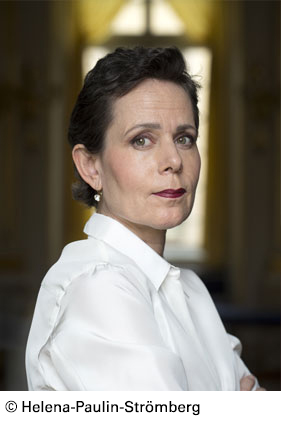October 2016, Year VIII, no. 10
Sara Danius
Nobel. A lady’s touch
“I’m tempted to say that of course it’s a gender issue - 228 years may seem like long time, and it certainly is, but on the other hand, we’re still waiting for our first Swedish queen in the modern era and, indeed, our first woman prime minister”
Telos: “1st June 2015. First woman ever at the top of the Nobel Prize organisation”. On the mass media, your appointment as Permanent Secretary of the Swedish Academy became a gender issue. What was your reaction?
Sara Danius: The Swedish Academy was founded in 1786 by King Gustaf III, and it has taken 228 years for it to appoint its first female Permanent Secretary. I’m tempted to say that of course it’s a gender issue - 228 years may seem like long time, and it certainly is, but on the other hand, we’re still waiting for our first Swedish queen in the modern era and, indeed, our first woman prime minister. It is important to bear in mind that I wasn’t appointed because of my gender, but because of my professional skills. A professor of Comparative Literature at Stockholm University, I received my MA at Nottingham University in the United Kingdom, and then went on to receive my PhD in Literature from Duke University, Durham, N.C. I have been a Fellow at the Wissenschaftskolleg zu Berlin, served as visiting professor at Michigan University, and have held appointments at the European Research Council as well as at The Swedish Research Council. In addition, I am a critic and essayist.
To get back to your question: I feel honoured that the Academy has entrusted me with the task of serving as Permanent Secretary. And at the same time, I feel tremendously privileged to represent the ambitions of so many women in the past and the present.
Lights turn on the Swedish Academy when the Nobel Prizes are awarded, but the Academy is actually at work all year long. What are the Academy’s day-by-day activities, Nobel Prize included?
The Nobel Prize is a crucially important task, entrusted to the Swedish Academy in 1901. The work is continuous, that is, it goes on all year round. In January, the Nobel Committee – currently comprising four members with three auxiliaries – receives proposals from a large number of individuals and institutions, and then adds its own candidates. The list typically amounts to some 350 names. A first distillation is produced in April, tending to consist of 20-25 names. At the end of May, a short list of five candidates is arrived at, to be approved by the Academy before the summer recess.
Then summer arrives. One would have thought it meant vacation. Well, yes and no. All eighteen members are sent home with an onerous to-do-list for the summer: to read every single text by the selected five authors. When the fall begins, all members are expected to return with a ranking, a solid opinion, and an open mind. In early October, and after vivid discussions, the Academy finally makes its choice. It then proceeds to announce the Nobel laureate of the year, a media-friendly event involving the now-famous Opening of the Door at the stroke of one p.m. The Nobel Prize in Literature is ceremoniously awarded on December 10. The Nobel Prize is important, but the Academy has a lot more on its plate. It awards some 60 literary prizes to writers, translators, scholars, essayists, and critics. Additionally, it is responsible for the publication of a series of lexicographic works, the most prominent being Svenska Akademiens Ordbok, or The Swedish Academy Dictionary, a historical project of 39 volumes to date. It is a comprehensive historical dictionary covering the Swedish language from 1521 to the present day. The closest international equivalent would be the Oxford English Dictionary. We expect to reach the final alphabetical letter in a few years’ time.
The Academy is also responsible for the publication of The Swedish Academy Glossary as well as The Swedish Academy Contemporary Dictionary. Our digital presence is considerable: the latter dictionaries are available as smartphone apps, whereas The Swedish Academy Dictionary is available as a free online resource. Another ongoing project is the publication of the classics of Swedish-language literature in elegant volumes with matte grey covers, also made available as a free online resource. These are some of the things we do.
The Nobel Prize for Literature is among those the public is most interested in. Is there anything you would change in the award selection criteria?
The answer is a simple one. No.
You are a cooking lover, indeed you have written cookbooks. Where did this passion come from? As Italians, we feel obliged to ask you: what is your favourite Italian dish?
I wish what you say would be true, but unfortunately, I am not an author of cookbooks. All I can brag about is that one of my sisters, Eleonora – I have six of them – is a successful food stylist. I’m keen on reading cookbooks, however, and have written essays on the art of cooking. One evening I happened on a Swedish classic, Bonniers kokbok. First published in 1960, it has come out in four editions to the present day. Each new edition is a mirror of its time, I discovered, and so I ended up writing a text about the past fifty years of Swedish cuisine. As I studied the changes over the years, I decided to look carefully at the methods proposed for preparing lobster, eel, and hare. I came to realize that what they say is true: the Swedish housewife is no more, as Monty Python would have it. This was no surprise, to be sure, but I hadn’t quite grasped the full dimension of her disappearance as far as Swedish civilization is concerned. In the 1960s, she was assumed to do the dirty work herself. For example, she would kill the living lobster using a sharp knife placed between its eyes. Then she would prepare a tasty – indeed seductive -- dish known as ”Lobster Armoricaine”. In much the same way, she was supposed to put down the living eel by way of nailing it onto the wall, punching it on the head with a hammer blow or two, and then flaying it from top to bottom, all the while using kitchen gloves and taking care not to get eel blood on herself as she might get an infection. As for the hare, the housewife was supposed to purchase it in one piece, skin and all, and then hang it upside down, flay it from top to bottom, and then chop its body into anatomically correct pieces. Today, the recipes are long gone – you can study their slow transformations from edition to edition --, and the cooking skills I referred to hardly exist anymore, except in professional kitchens. Indeed, nowadays the methods used seem alien, not to say disgusting, to the general population. You would perhaps think that the death of the housewife is a sign of progress. You might also think that the Swedish kitchen has been de-feminized. Neither, I realized, turned out to be quite true. Or to put things a little differently: Things are more complicated. What we have lost to the dustbin of history is an ideal sovereign figure, a dual character, both feminine and masculine, seducer and butcher, Eros and Thanatos. All in one. I’m not sure that Italy has gone as far as the Nordic countries have, but I’m certain that some tendencies can be seen. You ask me about my favourite Italian dishes. Whenever I visit my sister Maja and her family in Ferrara in Emilia-Romagna in northern Italy, I have pasta Ferrarese style at least once, that is, Cappellacci di Zucca al Burro e Salvia. Stuffed with pumpkin, the pasta is deliciously sweet to the taste. The dish is served with melted butter, quickly fried sage, and parmesan on top. It’s divine just to look at, what with its deep orange colour. I also love the Coppia, the typical Ferrarese bread. A household tip of mine is Rigatoni al Pomodoro e Ricotta à la Lorenzo de’ Medici, a wonderful recipe that I often simplify into a surprisingly tasty tomato sauce. Here’s the recipe: in a frying pan, pour 3 tbsp. extra virgin olive oil, add 4 chopped garlic cloves, perhaps a few chili flakes, cook over low heat for a few minutes until translucent, add 2 cans of organic plum tomatoes, let simmer until the liquid has evaporated, ca. 45 minutes. Add salt and black pepper to taste. Cook rigatoni according to the directions, stir pasta and tomato sauce together in a warm serving bowl, sprinkle basil on top, serve with lots of freshly grated Parmesan - et voilà! Your table guests will find it hard to believe the pungent sauce is so simple to make, I promise.
Editorial
Sara Danius is an intelligent, cultured, successful and powerful woman. Sara Danius is refined, elegant and extremely beautiful. Sara Danius is a cook, a good cook – just read the mouth-watering recipes she’s given us. All very surprising, you’ll say. No, not at all since Sara Danius is kind, available and lovely. Blast! Immediately after the official announcement of her nomination as Permanent Secretary of the Swedish Academy – the one that assigns the Nobel Prize in Literature – we instantly wrote to her secretary. We felt it would be an honour to interview her. And then, one Saturday evening, we received a mail, sent by Danius herself, answering our questions together with many kind words and thanks. To us. A mail to us after we had made an incredible boo-boo in our last question to which she had nevertheless unquestioningly answered in detail. I’ll say no more. You’ll have to go and read for yourselves so that when we hear you chuckling from afar, we’ll relive our embarrassment. Well, 228 years had to pass before a woman was named Permanent Secretary, and yet Danius says it would be superficial, no incorrect, to consider it a gender issue. Then, with a light-hearted stroke of her pen she tells us several behind the scene stories of the most sought-after prize in the world. A prize which, since 1901, follows a very rigid agenda throughout the year and ends on December 10, the day the Nobel Prize Award Ceremony takes place. An agenda she says is perfect the way it is. Who are the eighteen people who decide the winners? The eighteen members of the Academy do not reply to letters and questions about their prestigious appointment. Not least because they’re sworn to secrecy for fifty years. For half a century they are forbidden to reveal either the names of the chosen few, or how the votes are cast and the final ranking. A writer may loose the Nobel by one vote and never know. If unanimity is not achieved, the Nobel Prize may be awarded ex-aequo. Like every other year, this year’s list of individuals unhappy about the results will be anything but short. The group of disappointed hopefuls, tipped as probable winners of the Nobel up until the last minute, is no less important than that of the winners. So, in the end, it’s perhaps logical to conclude that in the history of the Nobel in Literature, it’s the illustrious absentees rather than the unknown winners who grab the headlines and cause a stir. This year the winner is anything but unknown. But still caused a stir. Bob Dylan and Sara Danius. A masterstroke.

Sara Danius is the Permanent Secretary of the Swedish Academy, the first woman to hold the prestigious position. She is Professor of Comparative Literature at Stockholm University; in addition, she is a well-known critic and essayist. Professor Danius was educated in Sweden, Britain, and the United States, and holds a doctorate from the Duke Universiry, Durham, N.C., in the United States, where she lived for ten years, as well as from Uppsala University, Sweden. She is the author of numerous books, among them The Sense of Modernism: Technology, Perception, and Modernist Aesthetics (Ithaca, N.Y., 2002); Nase für Neuigkeiten: Nachrichten von James Joyce (Vienna, 2008); Den blå tvålen. Realismen och konsten att göra saker och ting synliga (”The Blue Soap: Realism and the Art of Making Things Visible”, Stockholm, 2013); and Husmoderns död (”Death of the Housewife”; Stockholm, 2014). Her favourite Italian authors are Natalia Ginzburg and Italo Calvino. Currently she is at work on a project on Proust and homosexuality, Proust being one of her favourite research topics, starting from the time of her doctorate. Other research interests include the writings of Thomas Mann, James Joyce, Stendhal, Honoré de Balzac and Gustave Flaubert, with a particular emphasis on how aesthetics reflects the arrival of new technology. She is also a certified croupière and card dealer. Apart from her professional specialties, Sara Danius is particularly interested in design, handicraft, photographic history, and fashion history – with a faiblesse for Italian fashion designers.







SocialTelos